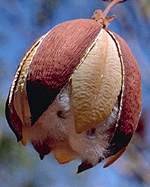 |
This small family of shrubs and trees is pantropical, usually in monsoonal areas with a pronounced dry season including the monsoon savannahs of northern Australia.
Characteristic features of the family Bixaceae in Australia include: - large-leaved shrubs or small trees, often dry-season deciduous
- leaves alternate, often palmately veined and gland-dotted
- flowers showy, open, with 5 free, yellow or pink petals and numerous stamens; ovary superior
- fruits are thin-walled, loculicidal capsules, some with copiously cottony seeds
Description
Evergreen or deciduous trees or shrubs. Internal secretions of coloured sap or essential oils. Plants with simple, non-glandular, unicellular hairs or peltate scales. Leaves (seasonally absent) alternate and spiral, petiolate. Stipules present, distinct and free from petiole, scale-like or membranous, falling off early. Lamina simple, or rarely compound, symmetric, palmatifid or palmatisect, lanceolate, ovate, oblanceolate or obovate; base cordate; margins entire, crenate or serrate, ±flat; venation palmate, with the midrib conspicuous, and the tertiary venation reticulate; surfaces dark-punctate; herbaceous. Plants with all the flowers bisexual. Inflorescences terminal, consisting of racemes or panicles. Bracts present. Pollination by insects and ?birds. Flowers odourless; stalked. Floral disc present; nectaries present on the disc. Perianth regular, of 2 dissimilar whorls, imbricate in bud. Calyx segments free, with 5 sepals, herbaceous. Corolla segments free, with 5 petals, alternating with the sepals, yellow or pink, without contrasting markings, membranous; claws absent; lobes notched, emarginate, bifid or bilobed. Fertile stamens numerous, not clearly correlated with sepals, free of the corolla, free of the ovary and style, distinct from each other, all ±equal. Anthers basifixed, not versatile, opening inwards by pores or by short slits; 2-celled. Ovary superior and sessile. Carpels 2–5, fused; ovary with 2–5 locules. Style terminal, single and unbranched and the stigma capitate. Ovules numerous per locule; stalked, placentation parietal or axile. Fruit a dry, dehiscent loculicidal capsule; the perianth on the maturing fruit deciduous. Disseminule macro-surface with straight hairs; micro-surface ±smooth, white, orange or brown, dull. Seeds numerous per fruit. Aril absent. Cotyledons 2. Embryo straight.
(Note: this description has been generated from the coded data compiled for the key. Any errors in the key data will be reflected in the descriptions.)
A treatment of the family Bixaceae has been published in:
Flora of Australia 8: 84-88.
Australian genera of Bixaceae (as recognised for the Flora of Australia)
* = all species introduced
*Bixa
Cochlospermum

|
  |

Bixa orellana (fruiting plant)
Photo: M.Fagg © M.Fagg

Cochlospermum fraseri (flowers and fruit)
Photo: J.Wrigley © ANBG

Cochlospermum fraseri (fruit)
Photo: J.Wrigley © ANBG

Cochlospermum gillivraei (flower)
Photo: M.Fagg © ANBG

|
 |
|